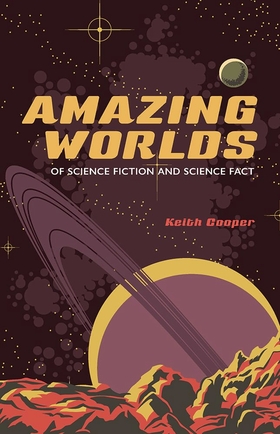Centauri Dreams
Imagining and Planning Interstellar Exploration
Schedule for Cassini’s Final Days
The Jet Propulsion Laboratory has just published details about Cassini’s last days and its final plunge into Saturn on September 15. That last act turns the craft into our first planetary probe of Saturn, to use Linda Spilker’s memorable phrase. A Cassini project scientist at JPL, Spilker goes on to note that the probe will be “sampling Saturn’s atmosphere up until the last second. We’ll be sending data in near real time as we rush headlong into the atmosphere — it’s truly a first-of-its-kind event at Saturn.”
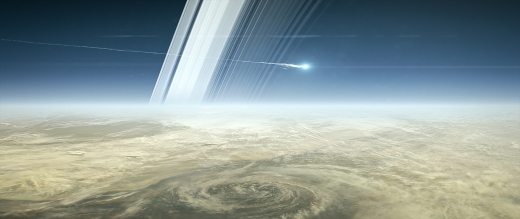
Image: Cassini streaks across Saturn’s sky in its final moments. Credit: NASA/JPL-Caltech.
I want to lift the Cassini final calendar out of this JPL news release, as many Centauri Dreams readers have expressed an interest particularly in the mission-ending atmospheric entry. We will likely lose radio contact within, JPL estimates, one to two minutes after the descent into the atmosphere begins. Eight of the twelve science instruments will be operating throughout the plunge, including the ion and neutral mass spectrometer (INMS), which will be sampling Saturn’s atmosphere. The imaging camera will be off during the descent.
The predicted time for loss of signal on Earth is 0754 EDT (1154 UTC) on September 15. JPL’s End of Mission Timeline is up and running, with a countdown clock and full schedule of events. The schedule below will probably be tweaked as we get closer to the final day, so keep checking the Timeline page as well as @CassiniSaturn on Twitter for updates.
Did you miss today’s preview of our #GrandFinale at Saturn? Catch the replay at: https://t.co/5adt2ODbgo pic.twitter.com/hFnqzg6miP
— CassiniSaturn (@CassiniSaturn) August 29, 2017
Here’s the schedule as it stands this morning:
- Sept. 9 Cassini will make the last of 22 passes between Saturn itself and its rings — closest approach is 1,044 miles (1,680 kilometers) above the clouds tops.
- Sept. 11 — Cassini will make a distant flyby of Saturn’s largest moon, Titan. Even though the spacecraft will be 73,974 miles (119,049 kilometers) away, the gravitational influence of the moon will slow down the spacecraft slightly as it speeds past. A few days later, instead of passing through the outermost fringes of Saturn’s atmosphere, Cassini will dive in too deep to survive the friction and heating.
- Sept. 14 — Cassini’s imaging cameras take their last look around the Saturn system, sending back pictures of moons Titan and Enceladus, the hexagon-shaped jet stream around the planet’s north pole, and features in the rings.
- Sept. 14 (5:45 p.m. EDT / 2:45 p.m. PDT) — Cassini turns its antenna to point at Earth, begins a communications link that will continue until end of mission, and sends back its final images and other data collected along the way.
- Sept. 15 (4:37 a.m. EDT / 1:37 a.m. PDT) — The “final plunge” begins. The spacecraft starts a 5-minute roll to position INMS for optimal sampling of the atmosphere, transmitting data in near real time from now to end of mission.
- Sept. 15 (7:53 a.m. EDT / 4:53 a.m. PDT) — Cassini enters Saturn’s atmosphere. Its thrusters fire at 10 percent of their capacity to maintain directional stability, enabling the spacecraft’s high-gain antenna to remain pointed at Earth and allowing continued transmission of data.
- Sept. 15 (7:54 a.m. EDT / 4:54 a.m. PDT) — Cassini’s thrusters are at 100 percent of capacity. Atmospheric forces overwhelm the thrusters’ capacity to maintain control of the spacecraft’s orientation, and the high-gain antenna loses its lock on Earth. At this moment, expected to occur about 940 miles (1,510 kilometers) above Saturn’s cloud tops, communication from the spacecraft will cease, and Cassini’s mission of exploration will have concluded. The spacecraft will break up like a meteor moments later.
By the JPL countdown clock, it’s just under 16 days to final signal received on Earth as I write this. It’s worth quoting Cassini project manager Earl Maize at this point:
“The end of Cassini’s mission will be a poignant moment, but a fitting and very necessary completion of an astonishing journey. The Grand Finale represents the culmination of a seven-year plan to use the spacecraft’s remaining resources in the most scientifically productive way possible. By safely disposing of the spacecraft in Saturn’s atmosphere, we avoid any possibility Cassini could impact one of Saturn’s moons somewhere down the road, keeping them pristine for future exploration.”
Cassini doesn’t have HAL’s AI smarts, but I keep thinking about the final burn Arthur C. Clarke’s famous computer gave to the Discovery in the film 2010: The Year We Make Contact. ‘Poignant’ only begins to explore the complex emotions I’m feeling as we prepare to lose this bird.

OSIRIS-REx: Course Correction Sets Up Gravity Assist
NASA’s OSIRIS-REx spacecraft, now on a two year outbound journey to the near-Earth asteroid Bennu, is a good deal closer to home than you might think. At play is a gravity assist maneuver that will take the craft past the Earth on September 22nd, propelling OSIRIS-REx into the orbital plane of its target. As of August 25th, the spacecraft was 16.6 million kilometers from the Earth.
Twenty-four days and a wake-up! You know I'm getting close when the one-way light time is under a minute.https://t.co/rACre4nDe4 pic.twitter.com/uvKBaNoqYM
— NASA's OSIRIS-REx (@OSIRISREx) August 28, 2017
The OSIRIS-REx team is reporting that a course adjustment burn was performed on August 23rd, a successful correction that marked the first time the spacecraft’s attitude control system (ACS) had been used in what is being called a ‘turn-burn-turn’ sequence. It’s a precision maneuver requiring the momentum wheels on OSIRIS-REx to turn the spacecraft so its thrusters are lined up for the burn. When the burn is complete, the momentum wheels turn the spacecraft back to its previous orientation. Thrust is monitored by an on-board accelerometer.
The maneuver on August 23rd lasted a scant 77 seconds, successfully changing the velocity of the spacecraft by 47.9 centimeters per second while using 0.46 kilogram of fuel. Precision work indeed, but just a warm-up for what will be needed at the asteroid, whose gravitational field is so weak that the smallest changes in velocity will allow exploration and mapping.
Its inclination adjusted — and there is the possibility of another Earth-targeting maneuver on September 12 if tracking data indicate it is necessary — OSIRIS-REx will begin its approach to Bennu in August of 2018, using its array of small rocket thrusters to perform a series of braking maneuvers, slowing the craft down by 0.53 kilometers per second. This will allow a relative approach velocity of about 20 cm/s, setting up a preliminary survey of Bennu in October of that year. At that point, the spacecraft will be essentially flying in formation with the asteroid.
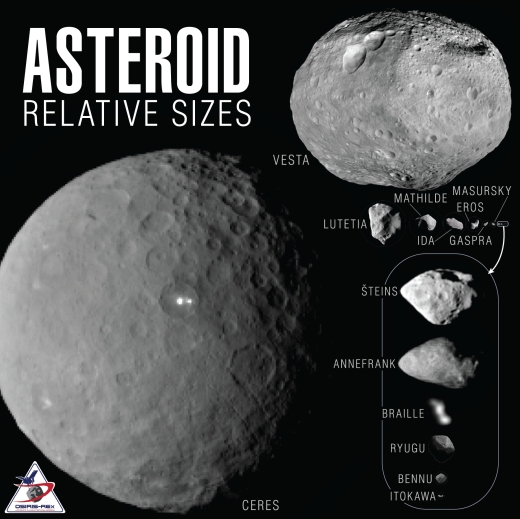
Image: Putting things into scale, this is a look at where the near-Earth asteroid Bennu fits in the asteroid catalog, a small object indeed toward the bottom of the chart. Credit: NASA/OSIRIS-REx team.
The survey of Bennu that begins after arrival in the fall of 2018 will last for a year, and will include four major phases:
- Preliminary Survey searches for asteroid plumes and natural satellites, and also measures the Yarkovsky acceleration of Bennu.
- Orbital A allows the Flight Dynamics Team to transition from star-based navigation to landmark-based navigation using images of Bennu’s surface.
- In Detailed Survey, several instruments work together to map Bennu and determine its global spectral, thermal, and geological properties.
- Orbital B continues to map Bennu at higher resolutions, with a focus on candidate sample sites. At the end of Orbital B a sample site will be selected.
That first item above is interesting. When working with asteroids, we have to take into account the Yarkovsky effect, which acts on rotating bodies in space and can be a significant influence on the the behavior of small asteroids. Daily heating of a rotating body in space can cause slow changes, producing a net force that causes a retrograde rotator like Bennu to gradually spiral inward toward the Sun. The effect has to be taken into account when calculating the object’s long-term trajectory, vital information for an Earth-crossing asteroid like this.
The OSIRIS-REx sample collection maneuver is to occur in July of 2020, when the craft makes a touch-and-go at a velocity of approximately 10 cm/s. Here the craft’s touch-and-go sample acquisition mechanism (TAGSAM) will be deployed, contacting the surface of Bennu for five seconds while releasing a burst of nitrogen gas that forces loose material into a collector. Up to three sampling attempts can be made, with a goal of 60 grams up to 2 kilograms of sample.
If all goes well, OSIRIS-REx will return its sample to Earth in September of 2023, jettisoning its sample return capsule (SRC) before performing a deflection maneuver to put the main craft into a stable orbit around the Sun. A soft landing in the Utah desert on September 24, 2023 is what mission planners are hoping for, and the chance for laboratory study of the asteroid’s chemical composition, including a search for organic compounds like amino acids and sugars.
Learning about Bennu’s physical properties will be helpful as we try to understand the distribution of molecular precursors to the origins of life on Earth. But it doesn’t hurt that we will also be learning a great deal about an object that itself has a faint chance of impacting the Earth late in the 22nd Century. A thorough knowledge of how it is made will help us understand how, if we ever have to do it, we will be able to adjust the trajectory of objects like these.
There is a useful mission overview and graphic timeline on the OSIRIS-REx site, which is likewise a good place to monitor mission developments. The mission’s Twitter account is @OSIRIS-REx.

Venus Automaton Design Recalls Mechanical Computers
I don’t usually talk about spacecraft close to our own Sun, but exceptions invariably arise. Centauri Dreams took a close look at the Parker Solar Probe back in June, because its operations close to the Sun (within about 10 solar radii) have implications for how we might build the kind of spacecraft that can perform ‘sundiver’ maneuvers, approaching the Sun before deploying a solar sail for maximum effect (see Parker Solar Probe: Implications for Sundiver). Sundivers are one way to maximize acceleration for future interstellar missions.
And then there’s Venus, a planet I’ve written little about in these pages. The Automaton Rover for Extreme Environments (AREE) concept study now being funded by the NASA Innovative Advanced Concepts program is intriguing because it looks at spacecraft design from a fresh angle, actually one that harkens back to generations of mechanical devices that have had little part in space exploration. At least, until now. For while the environment on Venus challenges all our surface rover concepts, a hybrid mechanical/electronic design might save the day. The implications for other extreme environments in the outer system are quite interesting.
AREE grows out of ideas first proposed in 2015 by JPL engineer Jonathan Sauder, who drew on his knowledge of mechanical computers, the sort of calculating machines that use levers and gears instead of microchips. Think of Charles Babbage’s Difference Engine, which was designed in the 19th Century, or the Greek Antikythera mechanism, which could tell the Hellenistic world in ancient times about upcoming astronomical events like eclipses.
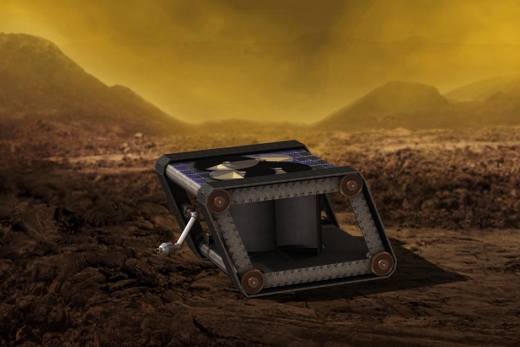
Image: AREE is a clockwork rover inspired by mechanical computers. A JPL team is studying how this kind of rover could explore extreme environments, like the surface of Venus. Credit: NASA/JPL-Caltech.
Sauder likes the idea of using analog technologies on Venus because electronics don’t last long under its extreme pressure and temperatures. If we can limit the use of electronics to the bare essentials and do the rest with analog techniques, we change the paradigm.
The power source? Wind turbines in the center of the rover, storing energy in a constant force spring. Tank treads, or something similar, would replace wheels, while communications would be handled by a rotating shutter placed in front of a bright radar target. The idea would be to turn the bright reflection on and off. Venus rover, meet the Royal Navy circa 1800 communicating with flags and signal lamps.
Build AREE right and you get long-duration in-situ mobility, a rover that might last on Venus’ hellish surface for a year or more (Soviet Veneras lasted for minutes or hours). Sauder considers it an automaton, ‘a mechanical device capable of performing a series of complex actions to achieve a specific result.’ I like the way AREE is described on this NIAC page:
[Automatons] have long been explored as art forms but remain unexplored for space applications. The automaton rover is designed to reduce requirements on electronics while requiring minimal human interaction and based on the subsumption architecture from robotics, where simple reactions of the rover lead to complex behavior. AREE combines steampunk with space exploration to enable science measurements unachievable with today’s space technology.
And the Phase 1 report notes: “High temperature electronics are incorporated where they have sufficient maturity and application, such as instrumentation.”
In other words, we are looking at a hybrid rover heavily dependent on mechanical methods but using electronics where needed. I hasten to add that this concept is maturing and may change substantially as a result of the Phase II work.
Consider the history of Venus exploration to see why alternate approaches are interesting. Venus’ surface reaches 460 degrees Celsius, hot enough to melt lead, while the surface pressures are high enough to crush the hull of a nuclear submarine at 90 bar. The Soviets attempted 14 landings in their Venera and Vega programs, nine of these being a success, but the sturdy probes lasted no more than two hours or so before being rendered inoperative.
“When you think of something as extreme as Venus, you want to think really out there,” said Evan Hilgemann, a JPL engineer working on high temperature designs for AREE. “It’s an environment we don’t know much about beyond what we’ve seen in Soviet-era images.”
The plan, then, is to bake mechanical prototypes of AREE to see how thermal expansion affects their moving parts. Phase 1 of the NIAC study compared mechanical rover technologies to electronics-based rovers using RTG cooling systems and designed to handle high temperatures, finding that current technologies were costly and not yet up to speed. The study also demonstrated the kind of passive signaling that would be deployed on AREE.
Phase II, now in progress, will set about finalizing the locomotion and signaling systems for the mechanical rover and creating a final rover design, a prototype that could perform initial testing. If AREE can work, it could change the game. One recent proposal for a Venus mission used a liquid gas cooling system that despite a price tag between $2 and $3 billion, could survive for less than a day on the surface. Sampling from multiple sites and developing longer-term weather data would be rendered impossible for this kind of device. AREE, with a sharply reduced electronics package, is a relatively low-cost mechanical alternative.
So we may one day be using levers and gears to produce calculations on this hellish world. We can only wonder what Charles Babbage might have made of the idea. Another reference is Pierre Jaquet-Droz, who along with his son produced mechanical automata in the 18th Century of extraordinary complexity. One of these, called The Writer, consisted of 6000 pieces, a mechanical boy with a primitive programmable memory who writes upon paper with real ink.
Mechanical computers experienced major growth in the early 1940s, and as Sauder’s Phase 1 report points out, were at their zenith by the 1940s. Nor were they simple affairs: They had gone from solving arithmetical problems to guiding bomb trajectories and aiming shipboard guns, taking atmospheric conditions into account. Sauder points to the Globus mechanical computer, an automaton that provided trajectory data for every Soviet launch until 2002. At the other end of the scale, mechanical watches and clocks can operate for decades — the oldest mechanical clock has been operated for 700 years. Throw in modern advances and we are now talking about a 10,000 year clock designed to function with minimal maintenance.
From the report:
Clever mechanisms can be combined with high temperature electronics to enable a platform that is more capable than either technology by itself. For example, one may consider simple addition. An electronic adder requires 576 transistors to combine two 16-bit numbers. To add numbers larger than 16 bits, multiple iterations through software would be required. However, a mechanical analog differential adder can solve the same problem using only 5 gears.
The goal, then, is to look critically at rover design to minimize the electronics package:
By finding these areas where mechanical solutions are relatively simple, the load on the computer can be reduced, thereby enabling a mission. Of course, a differential adder can only perform the adding operation, whereas a processor made up of many transistors can perform many other functions. But for an automaton, where the system is designed to carry out a specialized series of actions, this flexibility is not required.
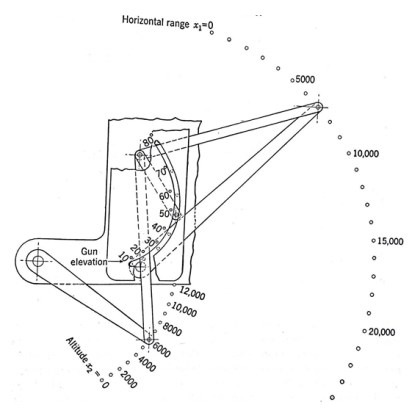
Image: Figure 9 from the Phase I report. A simple example of an analog mechanical computer with multiple inputs. Credit: Jonathan Sauder.
Note that the ability to make science measurements is what Sauder considers one of the greatest weaknesses of a purely mechanical system. We can think, then, of hybrid rovers in which electronics are reduced sharply in complexity by using mechanical analog systems where possible, but still deployed if necessary for high-resolution data. Back to the Phase I report:
Additional study is necessary to leverage the existing suite of high temperature electronics to make critical science measurements targeted towards the mission context. Furthermore, in the coming months it is expected several specific high temperature electronic technologies will be announced for further development through the Hot Tech program. The selection will define what scientific measurements will become the most relevant with soon to be released technology. Therefore, instead of focusing on instrument development, this [Phase 1] study focuses on developing a mobile platform for Venus and other extreme environments which could host various instrument payloads.
And now we move on to the Phase II study. A comeback for automata may prove useful not only on Venus but in any number of difficult environments where the data collection may be basic but persist for long periods of time. Operations near Jupiter, for example, produce significant radiation problems and demand extensive shielding for electronics, just as high pressure environments beneath planetary atmospheres (the interior of a gas giant) challenge the survivability of our best electronic probes. Venus could turn out to be an interesting test case for how we add mechanical methods into our toolkit of deep space exploration.
For more, see Sauder et al., “Automaton Rover for Extreme Environments,” NASA Innovative Advanced Concepts Phase 1 Final Report, available here.

Deep View of Antares
Red supergiants are stars more massive than 9 times the mass of the Sun, a late stage of stellar evolution in which the stars’ atmospheres become expansive, while lowering in density. Antares, the brightest star in the constellation Scorpius, is about 12 times as massive as the Sun, but its diameter is 700 times larger. Its mass was once thought to be 15 times that of the Sun, with three solar masses of material being shed during its lifetime. If located in our Solar System, its outer edges would reach somewhere between the orbits of Mars and Jupiter.
Now we have word that scientists using the European Southern Observatory’s Very Large Telescope Interferometer (VLTI) at Paranal Observatory in Chile have been able to map the surface of this star, and to measure the motion of its surface material. What we get out of all this is the best image of the surface and atmosphere of any star other than our own.
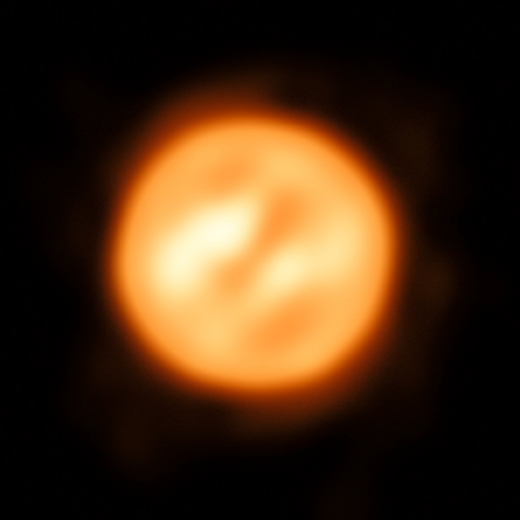
Image: VLTI reconstructed view of the surface of Antares. Credit: ESO.
Lead author Keiichi Ohnaka and colleagues were able to create a two-dimensional velocity map of Antares’ atmosphere, using three of the VLTI’s auxiliary telescopes — these are 1.8 meter instruments that feed the interferometer and can be moved from place to place on the VLT platform. The VLTI can combine the light of four different telescopes, using either its 8.2 meter ‘unit’ instruments or the smaller auxiliary telescopes. In this case, three of the auxiliaries were complemented by AMBER, a near-infrared spectro-interferometric instrument.
With the help of the latter, the team was able to make separate images of the surface of Antares over a small range of infrared wavelengths. The ensuing map of the relative speed of atmospheric gases across the Antares disk grew out of calculations revealing the speed differential between gas at different positions on the star, and the average speed of gas over the entire star.
We’d like to know more about how supergiants like Antares lose mass as they enter their final stages. The paper reveals that the distribution of turbulent low-density gas was unexpectedly complex. Its presence much further from the star than predicted could not be explained by convection, which involves the transfer of energy from the core to the outer atmosphere of many stars — the extended atmosphere is much larger than convection models can produce.
From the paper:
Since convection alone cannot explain the density and extension of the atmosphere, some yet-to-be identified process should be in operation to make the atmosphere extended and give rise to the turbulent motions and also perhaps the mass loss. Given that we did not detect a systematic outflow within 1.7 stellar radii, the substantial acceleration of mass loss should take place beyond this radius. The next challenge remains to identify the driving mechanism responsible for the observed turbulent motions.
Thus we move toward applying these techniques to different types of star, now that we have demonstrated the ability to study stellar surfaces and atmospheres in such detail.
And if you’re looking for an Antares reference in science fiction, it would be to the classic Alfred Bester tale The Stars My Destination, in which protagonist Gully Foyle ‘jaunts’ (teleports) into the system (one of many in which he pops up), to find the star “…encircled by two hundred and fifty planetoids of the size of Mercury, of the climate of Eden.” Work that out if you can. And if you haven’t read Bester yet, this one needs to be at the top of the reading stack.
Today’s paper is Ohnaka et al., “Vigorous atmospheric motion in the red supergiant star Antares,” Nature 548 (17 August 2017), 310-312 (abstract).

‘Diamond Sky’: Remembering The Cosmic Connection
Looking at recent headlines about ‘diamond rain’ on Neptune provoked a few thoughts about headline writers, though the image is certainly striking, but then I recalled that Carl Sagan used to enjoy pulling out the stops with language as much as anyone. Listen, for example, to the beginning of his 1973 title The Cosmic Connection:
There is a place with four suns in the sky — red, white, blue and yellow; two of them are so close together that they touch, and star-stuff flows between them.
I know of a world with a million moons.
I know of a sun the size of the Earth – and made of diamond.
There are atomic nuclei a mile across that rotate thirty times a second.
There are tiny grains between the stars, with the size and atomic composition of bacteria.
There are stars leaving the Milky Way. There are immense gas clouds falling into the Milky Way.
There are turbulent plasmas writhing with X- and gamma rays and mighty stellar explosions.
There are, perhaps, places outside our universe.
And so on. The Cosmic Connection was long on language and imagination, and in its day, ideal for bringing the findings of astrophysics to the attention of the general public. Back in 1973, when I wasn’t poring over medieval texts, I kept the book nearby and re-read various chapters, enjoying Sagan’s effusive enthusiasm. I can see him adding a line or two about the latest findings on the interior of ice giants like Neptune and Uranus, with his own poetic twist.
And diamonds raining down from a high-pressure ‘sky’ deep in Neptune’s atmosphere to the dark core beneath certainly create a striking image. They’re suggested by a new paper looking at the chemical processes going on inside such worlds, which has demonstrated a way of creating what the researchers call ‘nano-diamonds,’ carbon atoms compacted into useful objects we may one day use in everything from medical procedures to industrial cutting needs. Nano-diamonds are likely paralleled by much larger diamonds in planetary interiors.
Having a magical image translated into practical science — and with real-world applications to boot — makes this story the kind of attention-grabber Sagan would have loved. The work involves an international team led by Dominik Kraus (Helmholtz Zentrum Dresden-Rossendorf), with experiments taking place at the SLAC National Accelerator Laboratory in Menlo Park, CA.

Image: By conducting experiments at the Linac Coherent Light Source — one of the world’s most powerful X-ray lasers — an international team of researchers led by HZDR physicist Dr. Dominik Kraus was able to demonstrate that hydrocarbon compounds split into carbon and hydrogen inside ice giants such as Neptune, shown here. The carbon turns into a “diamond shower.” Credit: Greg Stewart / SLAC National Accelerator Laboratory.
The ice giants of our outer system – and doubtless in other systems – contain solid cores thought to be surrounded by different ices — hydrogen molecules connected to lighter elements. What Kraus and colleagues wanted to do was to simulate the environment 8000 kilometers down, where high pressure produces diamonds that fall as precipitation deep into the interior.
The environment inside an ice giant was simulated by creating shockwaves in plastic using an optical laser beam at the Matter in Extreme Conditions (MEC) instrument at SLAC’s Linac Coherent Light Source (LCLS). Carbon atoms in the original plastic emerged as part of nanometer-scale diamond structures. On Uranus or Neptune, the researchers believe, such diamonds would be considerably larger and would eventually sink to the planet’s core.
The polystyrene used in the experiments is made from a mixture of hydrogen and carbon, and is used to simulate compounds formed from the methane that gives Neptune its distinctive color. Deep below the clouds of the ice giants, methane forms carbon and hydrogen chains that respond to the high pressure further down by forming the kind of diamond rain observed.
At SLAC, the optical laser created pairs of shock waves in the plastic which, when overlapping, produced the pressure needed to form the diamonds. At this point, the reaction could be probed with 50 femtosecond X-ray pulses from the LCLS, a kind of X-ray snapshot of the reaction.
“For this experiment, we had LCLS, the brightest X-ray source in the world,” said Siegfried Glenzer, professor of photon science at SLAC and a co-author of the paper. “You need these intense, fast pulses of X-rays to unambiguously see the structure of these diamonds, because they are only formed in the laboratory for such a very short time.”
The phenomenon is fascinating enough on our own ice giants, but the work has interesting implications for exoplanets because better models of planetary interiors can change the way we evaluate the relationship between mass and radius. The researchers believe the infall of diamond rain could also prove to be an additional heat source as it approaches the core.
The SLAC work goes beyond earlier attempts to simulate the formation of diamonds in ice giants by capturing measurements in real time, a feat made possible here through the combination of the optical lasers at MEC combined with X-ray pulses from the LCLS. We wind up with a glimpse of high-pressure diamond formation that agrees with theory and gives us further insight into the conditions inside planets like these. And conceivably, the clumping behavior of matter observed in this and other matter compression studies could give us better insight into the fusion of forms of hydrogen into helium, a process we’ve yet to master.
Sagan’s diamond star? “Some white dwarfs are largely carbon,” he writes in The Cosmic Connection. “We may speak of a star made of diamond.” Not quite the same phenomenon as a rain of diamonds on Neptune, though he does go on to quote Bob Dylan’s “To dance beneath the diamond sky / With one hand waving free,” a poetic stretch we can still enjoy whether it’s raining or not.
The paper is Kraus et al., “Formation of diamonds in laser-compressed hydrocarbons at planetary interior conditions,” published online by Nature Astronomy, 21 August 2017 (abstract).

Getting Ready for TVIW 2017
I’ve spent part of each day recently working on a short presentation I’ll be giving at the Tennessee Valley Interstellar Workshop, coming up in early October. I like this year’s motto — “Step by Step: Building a Ladder to the Stars” — because it picks up on a theme I’ve cited here before, the maxim by Lao Tzu that “You accomplish the great task by a series of small acts.”

Despite its regional name, TVIW now draws speakers from all over the world. Co-founder Les Johnson encapsulates the idea behind the sessions, emphasizing the workshop concept:
“The Tennessee Valley Interstellar Workshop is an opportunity for relaxed sharing of ideas in directions that will stimulate and encourage Interstellar exploration including propulsion, communications, and research. The ‘Workshop’ theme suggests that the direction should go beyond that of a ‘conference’. Attendees are encouraged to not only present intellectual concepts but to develop these concepts to suggest projects, collaboration, active research and mission planning. It should be a time for engaging discussions, thought-provoking ideas, and boundless optimism contemplating a future that may one day be within the reach of humanity.”
Image: TVIW co-founder Les Johnson.
My talk will address the question of astrobiological markers in planetary atmospheres, given as part of what TVIW is calling their ‘Sagan Meetings.’ As I understand the format, each of the four speakers has the floor in turn, and then the speakers form a panel that engages in discussion on the topic with the audience. In addition to my biosignature session, there will be a Sagan session on ‘Flyby or Deceleration’ and one on gravitational lensing possibilities at 550 AU. I’m hoping Claudio Maccone will be there for that one to discuss his FOCAL mission.
There is still time to sign up for TVIW 2017, which runs from October 3 to 6 in Huntsville, AL. This year the TVIW organization is joined by Starship Century and the Tau Zero Foundation as co-sponsors, each taking charge of a single day.

Given the number of people who’ve been asking me about updates on Breakthrough Starshot, the meeting should be productive, as Starshot executive director Pete Worden will be there along with other key figures from the project including Jim Benford, Kevin Parkin (Parkin Research), Philip Lubin (UC-Santa Barbara) and Robert Fugate, who chairs the subcommittee responsible for the all-important laser array to drive the craft. Highlights will be key progress in the program and procurements that are beginning to get underway on phased lasers, sail materials and sail dynamics.
Image: Breakthrough Starshot executive director Pete Worden.
The gravitational lens and its prospects gets several nods in this year’s TVIW, as JPL’s Slava Turyshev talks about the prospects of using gravitational lens technologies for communications and imaging. We’ll also have a reality check on the whole concept from Geoff Landis (NASA Glenn). And on the matter of data return, David Messerschmitt (UC-Berkeley) will be taking on related issues like limited available energy, transmit and receive antennas, pointing accuracy, and speed as he describes the plan to return data from a fleet of chip-like star probes.

Tau Zero founding architect Marc Millis will be describing the uses to which the foundation is putting its recent NASA grant, while Gerald Jackson will offer a look at antimatter fuel production. He will be joined by Tau Zero board chairman Jeff Greason (Agile Aero). Greg Matloff (CUNY), author of The Starflight Handbook among so much else, has just let me know that he will be sitting in on several of the panel discussions. Andrew Siemion (UC-Berkeley), one of the leaders of the Breakthrough Listen initiative, should offer insights into where SETI is going and the status of the Listen project. All in all, the roster of speakers is too long to list in its entirety and I’ll send you to the current schedule to see it.
Image: Tau Zero founder Marc Millis.
As we’ve done before at TVIW, the sessions will occasionally break for ‘working tracks’ on issues like SETI, security and the steps needed to build a starfaring civilization. These afternoon sessions have been helpful in the past because participants are asked to produce a report that can be read back to the entire meeting, thus concentrating focus and guiding discussion. I should also note a panel discussion that will include congressman John Culberson (R-TX) in the mix, a proponent of deep space exploration who offers a practical political perspective.
See the TVIW 2017 page for accommodations and other details. A number of science fiction authors, including the aforementioned Geoff Landis as well as Larry Niven and Allen Steele, will be coming for a post-conference event on the 6th. Hope to see you there as well.


